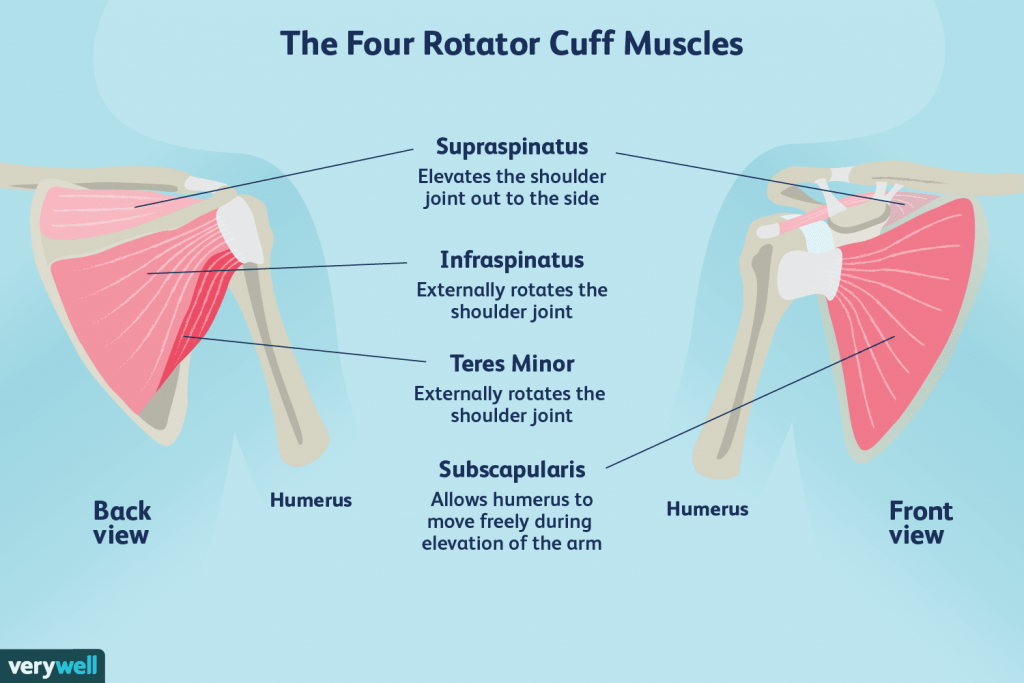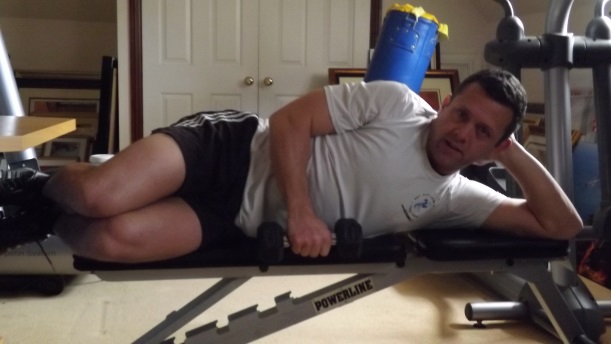Since lock-down began in March 2020 I have seen an increase in clients suffering with shoulder discomfort. It is no coincidence that a change in working conditions has had an effect here. More people are working from home, often sat at dinner tables or sitting on inadequate chairs. Long term repetitive movements from a relatively stationary position can wreak havoc on your musculoskeletal health. This can lead to bad posture, headaches and tendinitis. Previously only experienced by sports men and women people with sedentary jobs are now experiencing rotator cuff pain. Merely sitting with poor posture at your desk with your arms outstretched typing for extended periods may cause this tendinitis.
What is the Rotator Cuff?
The rotator cuff is a group of four small muscles and tendons that connect the shoulder blade to the top of the shoulder and the head of the upper arm bone. The rotator cuff gives the shoulder strength and stability while keeping the ball centred in its socket

THE MUSCLES:
SUPRASPINATUS – Stabilises the head of the humerus to initiate abduction
INFRASPINATUS – Lateral rotation of the humerus.
TERES MINOR – Lateral rotation of the humerus.
SUBSCAPULARIS – Medial rotation of the humerus.
How it Gets Injured
The
tendons of the rotator cuff are susceptible to age-related “wear and
tear” that may result in their thinning and tearing. Traumatic injury,
such as from a car accident or fall, can cause the rotator cuff to tear. It is
also prone to overuse, as we use it whenever reaching overhead or outstretching
our arm; that’s why athletes like baseball players, swimmers, and tennis
players are at greater risk for overuse injuries, including tendinitis
(inflammation of a tendon) and tears. Painters, electricians, and others who
frequently work with their arms in an overhead position are vulnerable, as
well.
Even people with sedentary jobs can have rotator cuff pain. For example, merely sitting with poor posture at your desk with your arms outstretched typing for extended periods may cause tendinitis.
The rotator cuff is one of the most important and most neglected group of muscles in the body. Most people will develop rotator cuff problems at some point in their lives unless they work on strength and flexibility specifically in this area. Have you ever heard of the expression, you’re only as strong as your weakest link? Well a weak or damaged rotator cuff will prevent you performing a lot of exercises and leave you with a weak and sometimes painful shoulder.
Weak or damaged rotator cuff muscles can also cause impingement – This is
when the rotator cuff muscle tendons become “Pinched” as they pass through a narrow space between the acromion process of the scapula (Shoulder Blade) and the head of the humerus (upper arm). Anything which causes further narrowing of this space increases the risk of impingement, such as osteoarthritic spurs on the acromioclavicular joint or thickening or calcification of the coracoacromial ligament. A loss of function of the rotator cuff muscles, due to injury or loss of strength, may cause the humerus to move superiorly, resulting in impingement.
Symptoms
The
primary symptom of rotator cuff injuries is pain along the side of the shoulder
or upper arm (pain rarely travels below the elbow). It can interfere with
everyday activities, such as reaching up to a high shelf, pulling on a coat, or
lifting heavy objects. Soreness may be more noticeable when you are trying to
sleep, especially when lying on the injured side. Rotator cuff injuries are
diagnosed through a physical examination and ultrasound or MRI imaging study
The
range of motion at the shoulder may be limited by pain. A painful arc of
movement may be present during forward elevation of the arm from 60° to 120°.
Passive movement at the shoulder will appear painful when a downwards force is
applied at the acromion but the pain will ease once the downwards force is
removed
RANGE OF
MOVEMENT OF THE SHOULDER:
These are
the optimum ranges the shoulder should experience. The range of motion of the
shoulder joint is a good indication of the state of the rotator cuff muscles.
If there are any imbalances work accordingly. Concentrate on the weak side
until the imbalance is corrected.
Internal rotation = 90`
External rotation = 50`
Horizontal Adduction =130`
Horizontal Abduction =30`
Flexion =180`
Extension =60`
Adduction =45`
Abduction =180`
TREATMENT
The
first treatment step is physical therapy, including a directed and supervised
program of shoulder-friendly exercises to strengthen and condition the muscles.
The goal is to get them working as efficiently as possible to reduce the risk
of shoulder pain. For people with desk jobs, postural training and adjusting
the workspace to promote ergonomic positioning are also important. More serious
or persistent cases may require Cortisone injections, surgery or debridement.
Check out the guide below on an efficient working posture. Make sure you set
your desk and seat correctly to reduce the threat of this painful injury

Maintaining
good posture and exercising regularly are things everyone can do to reduce the
risk of rotator cuff problems. To avoid overuse injuries, people who frequently
engage in overhead activities will benefit from a directed exercise program to
keep the rotator cuff as strong as possible. If you are now working from home,
improving your posture and maintaining an ergonomic workspace are essential as
a prevention measure
If
you are suffering from rotator cuff pain or you are concerned and would like
exercises to prevent possible injury please e-mail Mark@nltraining.co.uk
Treatments
would typically focus at maintaining range of movement, improving posture,
strength of the muscles of the shoulder
and scapula, and reduction of pain. To improve pain and function : Joint
mobilisation, interferential thereapy, acupuncture, soft tissue therapy,
therapeutic taping, scapular and rotator cuff strengthening, band education
regarding the cause and mechanism of the condition will help
During exercises you should
not experience any popping or clinking in the shoulder. If this happens reduce
the weight or adjust the position of the scapula or the upper arm. No
discomfort should be experienced
THE EXERCISES:
Here are
some exercises to help strengthen the rotator cuff muscles. It is recommended
you undertake these under the supervision of a trainer for the first time.
LYING L
Objective: To rotate the upper arm at the shoulder
joint.
How: Lie on
the side on the floor. Use a pillow or support the head with one arm. Place a light
dumbbell in the other hand. Place the elbow firmly against the side of the body
with the elbow flexed at 90`. Keeping the wrists straight and maintaining the
90` angle at the elbow joint move the dumbbell towards the ceiling, then back until
it is in line with the body.
Teaching
pts: Ensure the wrists are straight.
Keep the neck relaxed
Keep the scapula pulled down
and in line with the spinal column.
Keep
elbow in contact with the hip bone


LYING INTERNAL / EXTERNAL ROTATION
Objective: To rotate the upper arm.
How: Lie on the back, knees bent. Hold a dumbbell in one hand. The upper arm should be at a 90` angle to the body, and the elbow should be at 90`. Keeping these angles, move the dumbbell as far in both directions as you can comfortably and under full control while keeping the shoulder on the ground.
Teaching pts:
Keep the upper arm at 90`.
Keep wrists rigid
Keep neck and shoulders relaxed
Keep scalpula in line with your spinal column. Range of motion will be different between clients, monitor the range and work gradually towards improvement



PRONE ROW
WITH EXTERNAL ROTATION
Lay face down on a bench; rotate your hand so the thumb is facing towards the
body. Perform a bent-over rowing motion with the elbow in the same plane as the
shoulder, and stop when the elbow is level with the shoulder. After achieving
this position, rotate the arm upwards until the forearm is just below parallel
with the body. Next, rotate the forearm back down to the previous position, and
then lower the arm back down to the starting position.



These are just a small sample of exercises that can
be performed. While all of these are very good at isolating the rotator cuff,
not all may be appropriate to perform initially during a rehabilitation
program.
It is also important to note that the rotator
cuff is an endurance type of muscle group, and therefore requires the use of
lighter weights and high repetitions. I typically start my clients with 3 sets
of 15 repetitions, and will progress to 5 sets of 30 repetitions depending on
the particular exercise being performed and progress being made.
It must
be stressed that all exercises performed with dumbbells must be performed with
light weights (2-3 pounds); using heavy weights will strengthen the larger
muscle groups more (deltoids, lats) resulting in a possible muscular imbalance.
If you
suffer from any shoulder problem or would like to test out your shoulder
mobility and strength contact Mark on 07771 985015 or email
mark@nltraining.co.uk for more details.


